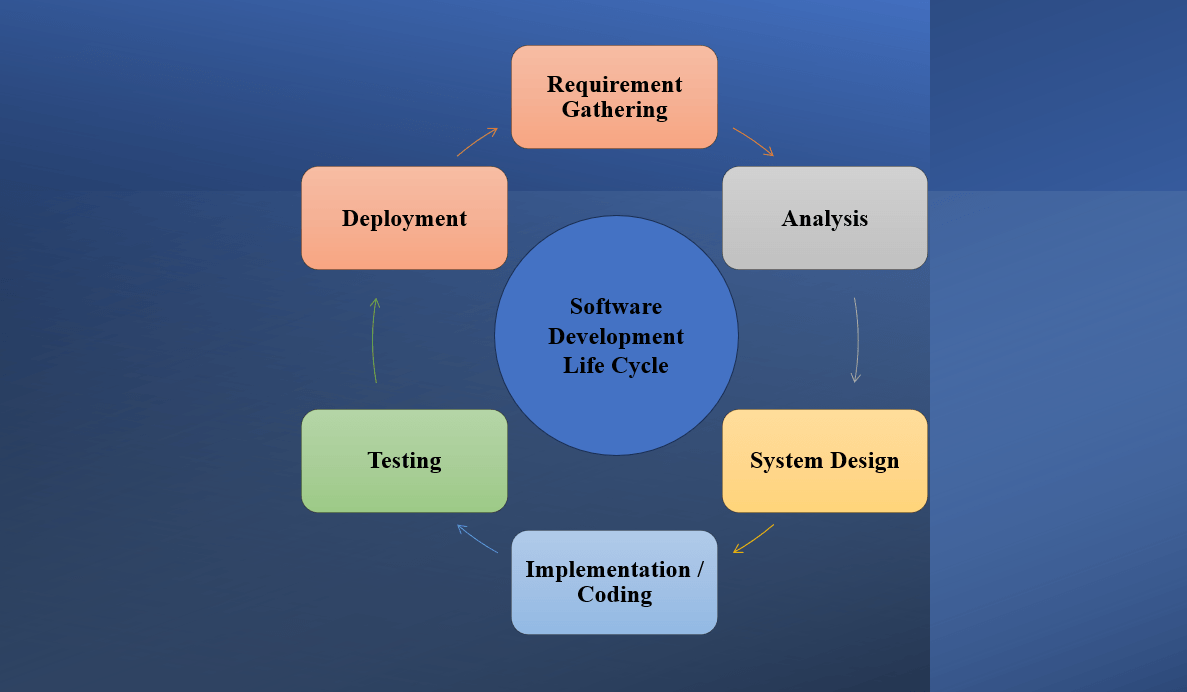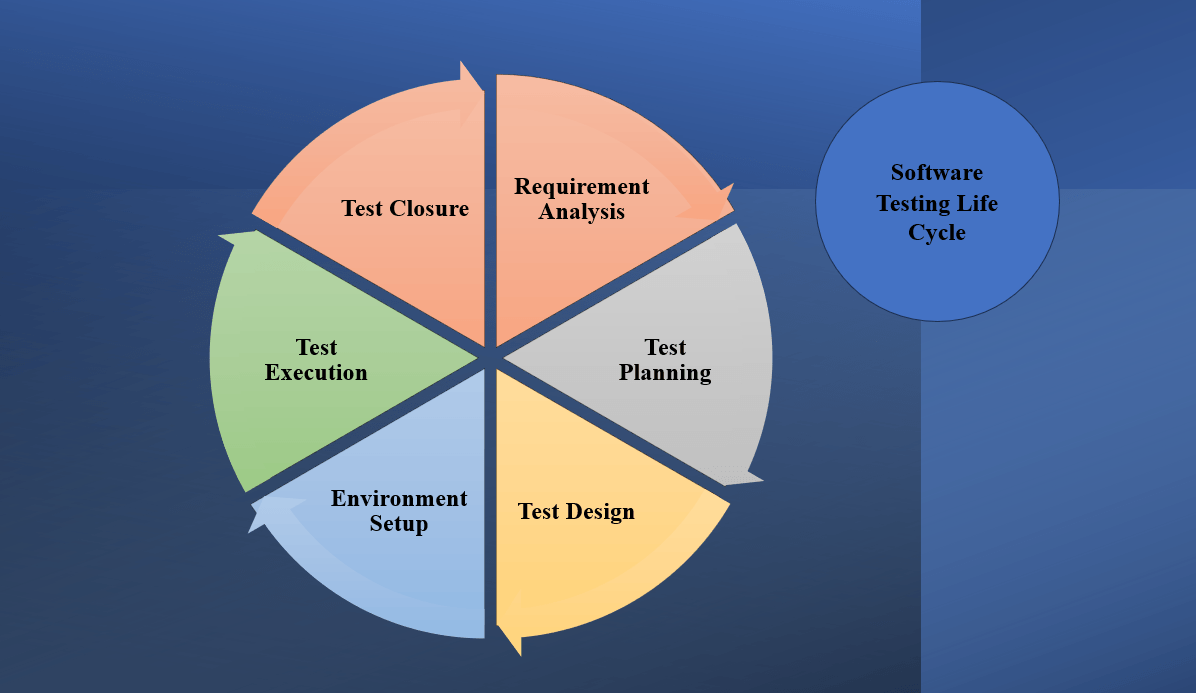1. Introduction
In this tutorial, we’ll look at the concepts of the software development life cycle (SDLC) and software testing life cycle (STLC).
2. What Is Software Development Life Cycle?
The Software Development Life Cycle (SDLC) is a structured approach in software engineering. It guides the process of developing high-quality software systems. It consists of phases that software goes through, from concept to deployment and maintenance:

The SDLC framework organizes and manages software development projects efficiently and effectively. It ensures projects are completed within predefined time and budget constraints.
2.1. Different Phases in SDLC
SLDC has various phases that guide the development process of software systems:
Phase
Description
Requirements Gathering
In this phase, stakeholders and users gather and document software requirements.
System Design
The system design phase involves creating a detailed plan for the software system, including architecture, user interface, and database structure.
Implementation
This phase involves coding and programming the software based on the design specifications. It includes writing, testing, and integrating components.
Testing
In the testing phase, the software is thoroughly tested to identify and fix defects or errors. This includes unit testing, integration testing, system testing, and user acceptance testing.
Deployment
The deployment phase involves releasing the software for production after being tested and approved. It includes installation and configuration in the target environment.
Maintenance
The maintenance phase focuses on monitoring and maintaining the software to ensure optimal performance, security, and reliability. It involves addressing user feedback and releasing updates or patches as needed.
These phases provide a structured framework for developing software systems, ensuring a systematic and organized approach throughout the SDLC.
2.2. Importance of Following a Structured SDLC Approach
Following a structured SLDC is of great importance for several reasons:
- it allows us to maintain a systematic and organized development process
- helps us identify and mitigate potential risks early on
- enables us to allocate resources efficiently and manage projects effectively
- it ensures proper planning and requirement gathering to establish clear project goals
- better time and cost management results from effective resource allocation and project scheduling
- it promotes rigorous testing and quality assurance, resulting in reliable and robust software systems
Furthermore, it fosters better collaboration and communication among team members and enhances our software products’ quality and reliability.
By adhering to a structured SDLC approach, we can streamline our development efforts, deliver projects on time and within budget, and effectively meet our customers’ expectations.
3. What Is Software Testing Life Cycle?
The Software Testing Life Cycle (STLC) is the step-by-step process used to test software and ensure it works well.
It consists of several phases:

STLC is important because it helps us find any problems or mistakes in the software, ensuring its high quality. By following the STLC, software developers can provide a reliable product to the people using it.
3.1. Different Phases in STLC
The software testing life cycle consists of various phases that guide the software testing process. Each phase has a specific purpose and contributes to ensuring the quality and reliability of the software:
Phase
Description
Test Planning
In this phase, we plan what and how to test. We make schedules and plans for the testing.
Test Case Development
In the test case development phase, we create instructions to check if the software works correctly. We also prepare the data needed for the tests.
Test Environment Setup
The test environment setup phase is about getting everything ready for testing. We set up the computer, software, and tools needed for the tests.
Test Execution
In the test execution phase, we run the tests. We check if there are any problems or mistakes in the software. We write down any issues we find.
Test Closure
The test closure phase is when we finish the testing. We analyze the test results, write reports about the tests, and record what we learned. We also review and close any issues found during testing.
These phases give a structured approach to testing software and ensuring it works well.
3.2. Importance of Following a Structured STLC Approach
The key objectives of SLTC are to test software thoroughly, find and fix problems, and improve software quality.
This helps us in a few important ways:
- it provides us with a clear plan and organized process for testing, ensuring that everything is done correctly
- It also helps us in planning and using our resources effectively
- following a structured STLC approach helps us find and fix problems in the software early on
So, by following the STLC, we ensure the software is good quality. This leads to satisfied customers and saves time and money in the long run.
4. Relationship Between SDLC and STLC
SDLC encompasses the entire software development process, while STLC focuses explicitly on the testing phase. Both cycles work together to ensure the software’s quality, functionality, and reliability.
Testing activities conducted during STLC provide valuable feedback to SDLC, allowing for necessary refinements and improvements.
4.1. How STLC Fits Within the Broader Context of SDLC?
SDLC covers the entire software development process, including planning, analysis, design, coding, testing, deployment, and maintenance. STLC is a part of SDLC and focuses specifically on testing.
STLC includes activities like test planning, test case development, test execution, defect tracking, and closure. These testing activities occur at different SDLC phases to check if the software functions well, performs efficiently, and is easy to use.
The outcomes of testing provide valuable feedback for the development process. Any defects or issues found during testing are addressed by the development team, leading to improvements in the software. This feedback loop between STLC and SDLC contributes to the overall quality and reliability of the software product.
4.2. Comparison of SDLC and STLC
While SDLC focuses on the overall development of software, STLC specifically deals with the testing phase:
SDLC
STLC
Focus
Entire software development process
Testing phase of the software development process
Objective
Develop high-quality software systems
Ensure software quality through thorough testing
Phases
Planning, analysis, design, coding, etc.
Test planning, test case development, execution, etc.
Activities
Requirements gathering, coding, deployment, etc.
Test planning, test execution, defect tracking, etc.
Outcome
Software product
Tested software with identified defects
Relationship
SDLC encompasses STLC
STLC is a subset of SDLC
Feedback
Testing outcomes feed back into SDLC
Defects identified during testing are resolved in SDLC
Interdependency
Testing aligns with development phases
Testing impacts the development process
Aligning activities between SDLC and STLC is crucial for our effective software development and testing. By aligning SDLC and STLC, we can ensure thorough testing at each phase of the development process, resulting in high-quality software that meets the expectations of our users.
5. SDLC Phases and Their Corresponding STLC Activities
In each SDLC phase, there are specific STLC activities that align with the corresponding development activities:
SDLC Phase
Corresponding STLC Activities
Requirements Gathering
Requirements analysis, test planning
System Design
Test design, test environment setup
Coding
Test case development, test data preparation
Integration and Testing
Integration testing, system testing
Deployment
Acceptance testing, regression testing
Maintenance and Enhancement
Maintenance testing, retesting, regression testing
This ensures that testing is performed effectively and comprehensively throughout the software development process.
6. Challenges and Best Practices in Coordinating SDLC and STLC
Coordinating SDLC and STLC can present challenges, but we can overcome them by following best practices.
One challenge is the communication gap between our development and testing teams, which we can address by encouraging regular communication and fostering an open and collaborative environment. We can manage time constraints by properly allocating time, prioritizing critical test scenarios, and automating repetitive tests.
Dealing with changing requirements involves maintaining close collaboration and embracing agile methodologies. Ensuring test environment availability requires proactive planning and setting up dedicated environments. Therefore, efficient defect management involves establishing a robust process for tracking and resolving defects.
Lastly, comprehensive documentation and knowledge-sharing sessions can improve documentation and knowledge transfer.
7. Conclusion
In this article, we explored two vital aspects of software engineering: SDLC (Software Development Life Cycle) and STLC (Software Testing Life Cycle). SDLC covers the entire software development process, while STLC concentrates on testing.
Aligning SDLC and STLC enables us to detect defects early, optimize resources, improve communication, ensure a seamless workflow, and enhance software quality. Thorough testing at each development phase is achieved through this alignment, resulting in high-quality software that meets user expectations.